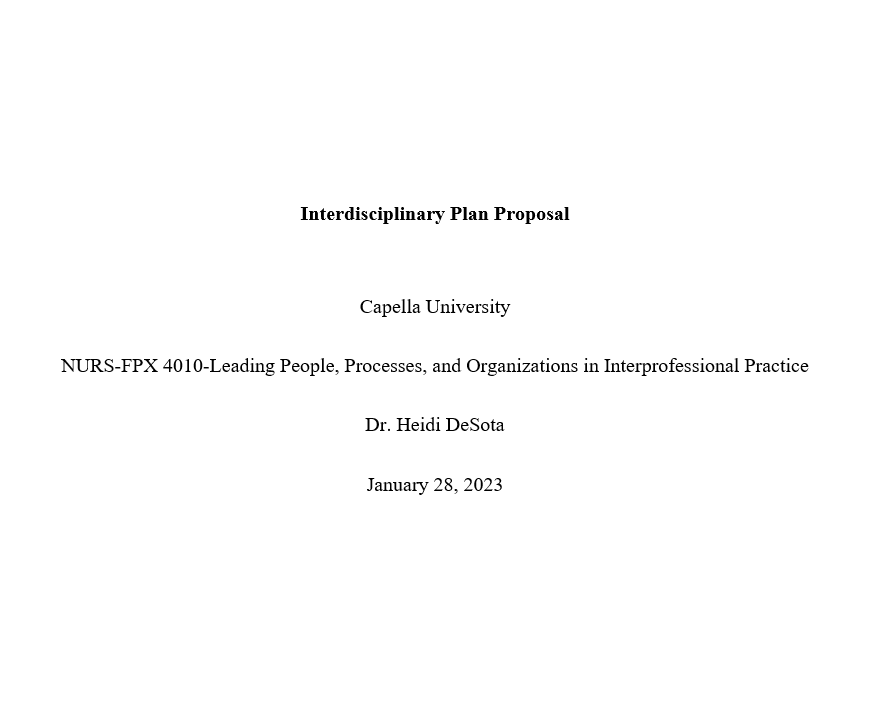Interdisciplinary Plan Proposal
Capella University
NURS-FPX 4010-Leading People, Processes, and Organizations in Interprofessional Practice
Dr. Heidi DeSota
January 28, 2023
Interdisciplinary Plan Proposal
The identified organizational issue is surgical site infections. The problem undermines the facility’s commitment to optimizing quality indicators and patient outcomes. The organization can benefit from interdisciplinary safety rounds, where individuals use safety checklists to identify risks, report, and collaborate in intercepting elements that contradict strategic priorities.
Interprofessional collaboration reminds everyone in the care team about their roles in monitoring and controlling risks that undermine the quality and safety of patient care. This plan reminds physicians, pharmacists, therapists, nurses, clinical assistants, and the nurse manager about their roles in sharing knowledge, skills, and experiences on vulnerabilities in the clinical environment and the best practices for delivering patient-centered care.
Objectives and Predictions
- To explain organizational resources needed to initiate interdisciplinary collaboration for preventing surgical site infections. The prediction is that the facility will mobilize and allocate the resources that help inform the care team about safety rounds and collective responsibilities for optimizing care outcomes.
- To explain the role of interdisciplinary collaboration in enabling the organization to prevent surgical site infections. The prediction is that leaders will facilitate collective buy-in necessary for making everyone dedicated to complying with interdisciplinary safety rounding checklists for identifying and intercepting risks.
- To discuss a change management model and leadership strategies appropriate for helping the care team overcome surgical site infections. The prediction is that everyone will appreciate calls for a shared vision and direction for identifying and intercepting risks associated with surgical site infections (Qvistgaard et al., 2019).
Change Theory and Leadership Strategies
Change management makes organizations more responsive to patients’ needs. The Plan-Do-Study-Act (PDSA) model is the viable option adopted to help the interdisciplinary team improve the quality of care. The framework reminds the care team about their roles in making services safer, efficient, patient-centered, and effective (Crowfoot & Prasad, 2017; McGowan & Reid, 2018). Preventing surgical site infections is among the practices that require an interdisciplinary group to utilize the PDSA model. Similarly, the process requires a transformational leader to guide the team through the four stages of the model. (NURS-FPX4010_C_Assessment 3-1 Solution.docx)
The leader encourages, inspires, and motivates everyone to share suggestions on the best practices for achieving intended outcomes (Clausen et al., 2019). For these reasons, the transformational leader will initiate the planning process by clarifying objectives based on the identified situation and the need to improve quality of care. The PDSA model allows the leader to implement the interdisciplinary safety rounds by observing outcomes and making the necessary adjustments (Crowfoot & Prasad, 2017). The care team acts to implement improvements such as effective use of interdisciplinary safety rounds checklists. The transformational leader identifies modifications and makes informed conclusions about feasibility of the safety rounds in the future.
Collaboration Strategy
As mentioned, the interdisciplinary team has physicians, pharmacists, therapists, nurses, clinical assistants, and the nurse manager. The team’s frontline experiences allow them to share accurate and complete insights into the risks factors and improvements necessary to prevent surgical site infections. The leader will clarify the need for an open, honest, and transparent environment (Sigmon, 2020). Effective communication is another consideration that will ensure everyone understands the objective and direction for implementing interdisciplinary safety rounds to prevent surgical site infections. Further, mutuality will allow the team members to embrace attitudes, behaviors, and values appropriate for supporting an interdisciplinary solution.
Resources
The change process requires the organization to mobilize and allocate resources for streamlining training and education on interdisciplinary safety rounds. Adequacy of the resources is a priority to avoid disruptions when engaging the care team about the best practices for understanding surgical site infections and the need for timely interventions.
Table 1
Resources
| Resource in the Order of Relevance | Description | Cost ($) |
| Interdisciplinary safety round checklists | The checklists describe action steps necessary to make the care team vigilant in identifying and intercepting risks associated with surgical site infections. | 200 |
| Case study | The case scenario describes causes, consequences, and the need for interdisciplinary interventions to enhance the quality and safety of patient care. | 100 |
| Video session | The team will utilize video simulations to understand their roles and responsibilities in identifying and intercepting risks associated with surgical site infections. | 400 |
| Role-play guides | The training entails equipping the care team with practical knowledge and skills in addressing the various aspects of surgical site infections. | 200 |
| TOTAL | 900 |
References
Clausen, C., Emed, J., Frunchak, V., Purden, M., & Sol Bruno, F. (2019). Toward resilient nurse leaders: The leadership-in-action program in nursing (LEAP-IN). Nursing Leadership, 32(3), 40–56. https://pubmed.ncbi.nlm.nih.gov/31714206/
Crowfoot, D., & Prasad, V. (2017). Using the Plan-Do-Study-Act (PSDA) cycle to make change in general practice. InnovAIT, 10(7), 425-430. https://journals.sagepub.com/doi/abs/10.1177/1755738017704472
McGowan, M., & Reid, B. (2018). Using the Plan, Do, Study, Act cycle to enhance a patient feedback system for older adults. British Journal of Nursing, 27(16), 936–941. https://pubmed.ncbi.nlm.nih.gov/30187794/
Qvistgaard, M., Lovebo, J., & Almerud-Österberg, S. (2019). Intraoperative prevention of Surgical Site Infections as experienced by operating room nurses. International Journal of Qualitative Studies on Health and Well-being, 14(1), 1-8. https://www.tandfonline.com/doi/pdf/10.1080/17482631.2019.1632109
Sigmon, L. B. (2020). Interprofessional collaboration made easy. American Nurse Today, 15(11), 36-38.

